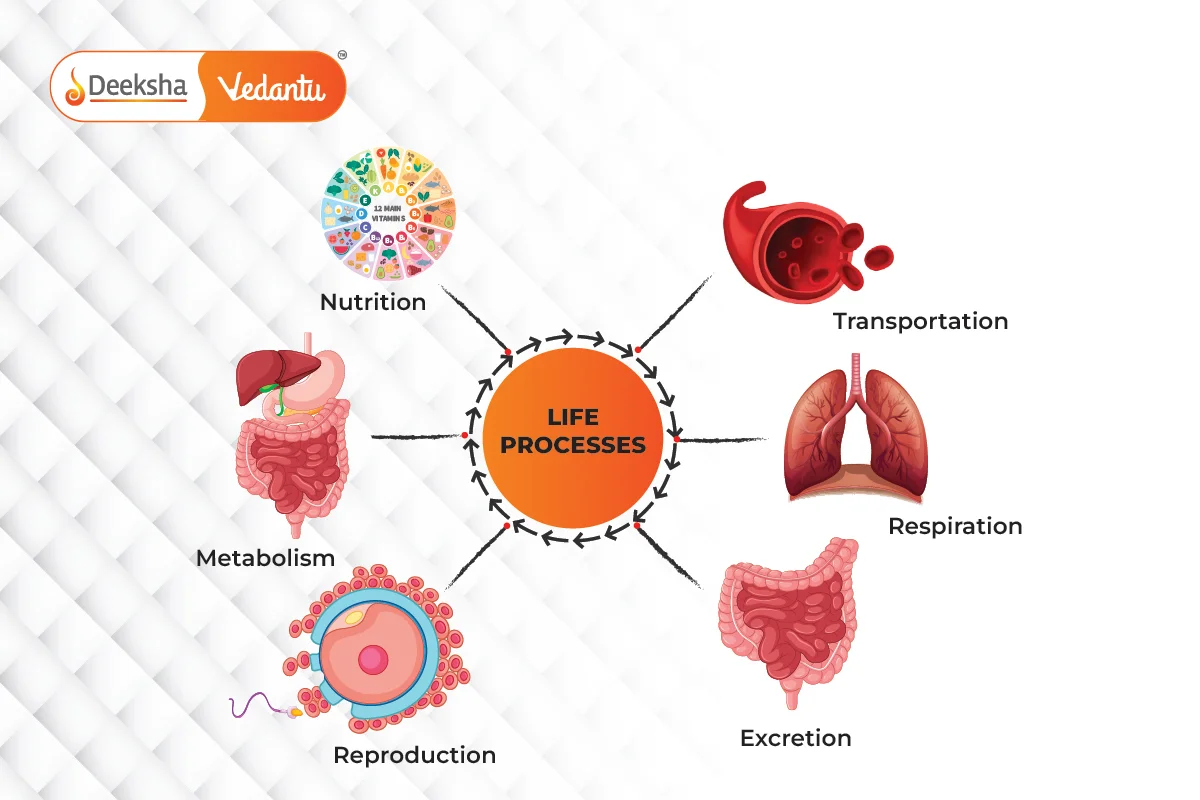Life processes are a set of essential functions carried out by living organisms to maintain life. These processes ensure survival, growth, development, and reproduction. The primary life processes include nutrition, respiration, transportation, and excretion. All these processes are interconnected and crucial for maintaining the balance and functioning of an organism.

Key Functions of Life Processes:
The key functions of life processes refer to the essential activities that living organisms perform to maintain life. These processes ensure growth, development, and the maintenance of homeostasis. The key functions include:
1. Nutrition
- Autotrophic: Organisms like plants synthesize their own food through photosynthesis.
- Heterotrophic: Organisms (animals, humans) that rely on consuming other organisms for food.
- Purpose: To provide energy and raw materials for the body’s functioning, repair, and growth.
2. Respiration
- The process of breaking down food (glucose) to release energy. This occurs in cells, with oxygen typically used to convert glucose into energy (ATP).
- There are two types:
- Aerobic respiration: Uses oxygen.
- Anaerobic respiration: Occurs without oxygen.
- Purpose: To generate energy for all cellular processes.
3. Transport (Circulation)
- Involves the movement of nutrients, gases (oxygen and carbon dioxide), and waste products throughout the body.
- In animals, this is done by the circulatory system (heart, blood vessels).
- In plants, water and nutrients are transported via the xylem and phloem.
4. Excretion
- The removal of metabolic waste products from the body.
- In animals, this is done by the excretory system (kidneys, skin, lungs).
- In plants, waste is excreted through stomata or stored in other forms.
- Purpose: To prevent the accumulation of harmful substances.
5. Growth and Development
- Organisms grow by increasing in size and cell number.
- Development involves the changes an organism undergoes as it matures and completes its life cycle.
6. Reproduction
- The process by which organisms produce offspring.
- It can be:
- Asexual reproduction: One parent produces offspring (common in unicellular organisms, some plants, and simple animals).
- Sexual reproduction: Involves the fusion of gametes (sperm and egg) from two parents.
7. Regulation (Homeostasis)
- The ability to maintain a stable internal environment despite changes in external conditions (e.g., body temperature, pH levels).
- This is achieved through feedback mechanisms (e.g., the release of insulin to regulate blood sugar).
8. Metabolism
- The sum of all chemical reactions in the body.
- Metabolism includes two processes:
- Anabolism: Building up of complex molecules from simpler ones.
- Catabolism: Breaking down complex molecules into simpler ones to release energy.
These life processes are fundamental to the survival of organisms, enabling them to grow, adapt, and reproduce.
What Defines Life?
Living organisms must constantly maintain and repair their structures. The cellular components of living organisms are prone to wear and tear, and the environment often influences this process. Life processes ensure the continuous maintenance and repair of cells.
Energy for Life Processes:
Life processes require energy, which comes from the environment in the form of food. Once food is consumed, it is broken down, and its energy is converted into a usable form (ATP) through cellular respiration. In addition to energy, organisms need raw materials (carbon-based molecules) to grow and maintain their structures.
Real-Life Example:
Consider a human sitting still or asleep. Even though the person appears inactive, life processes such as respiration, circulation of blood, and excretion are actively occurring. These processes continue to function to maintain life and prevent the breakdown of the body’s systems.
Conclusion:
Life processes are fundamental to the existence of living organisms. They include a series of chemical reactions and functions that allow organisms to take in nutrients, produce energy, transport materials, and eliminate waste. These processes are essential for maintaining life and ensuring the organism’s survival and continuity.
Practice Questions:
Q1: What are the main life processes in living organisms?
- Answer: The main life processes are nutrition, respiration, transportation, and excretion. These processes are essential for maintaining homeostasis and enabling growth, repair, and reproduction.
Q2: Why do living organisms need energy?
- Answer: Energy is required for carrying out various life processes such as movement, growth, repair, and the maintenance of body systems. It is obtained through the breakdown of nutrients during respiration.
FAQs
Autotrophs synthesize their food through processes like photosynthesis, while heterotrophs rely on other organisms for their food.
Nutrition provides organisms with the necessary energy to carry out life processes, promotes growth, and maintains the body’s functions.
Enzymes act as catalysts that break down complex food molecules into simpler ones, which can then be absorbed and used by the body for energy and growth.
Specialized tissues, such as xylem in plants for water transport and red blood cells in animals for oxygen transport, allow organisms to efficiently carry out life processes and sustain themselves.
Energy is produced through the breakdown of glucose during respiration. This process generates ATP, which is used by cells to perform various functions.
Life processes such as nutrition, respiration, transportation, and excretion ensure that organisms maintain homeostasis, grow, and reproduce. Without these processes, organisms would not be able to survive.
Double circulation ensures that oxygen-rich blood is separated from oxygen-poor blood, improving the efficiency of oxygen delivery to body tissues.
While photosynthesis produces glucose (food), respiration breaks down glucose to release energy for cellular activities. Both processes are necessary for survival.
Enzymes catalyze the breakdown of large food molecules into smaller, absorbable molecules. For example, amylase breaks down starch into maltose.
Related Topics
- Overview of Food Chain
- Biodiversity
- Ecosystem
- Nutrition
- Heredity
- Biology FAQs
- Sexual Reproduction
- Modes Of Reproduction Used By Single Organisms
- Cells
- Accumulation Of Variation During Reproduction
- Do Organisms Create Exact Copies of Themselves?
- Prokaryotic and Eukaryotic Cells
- Life Processes
- How do Organisms Reproduce?
- Mitochondria







Get Social